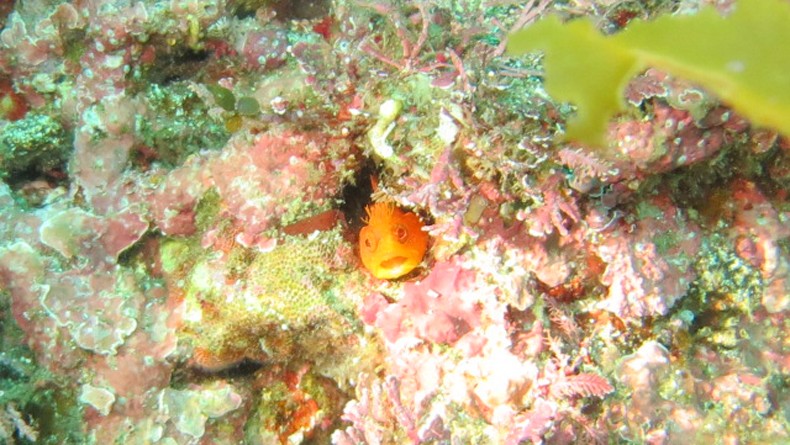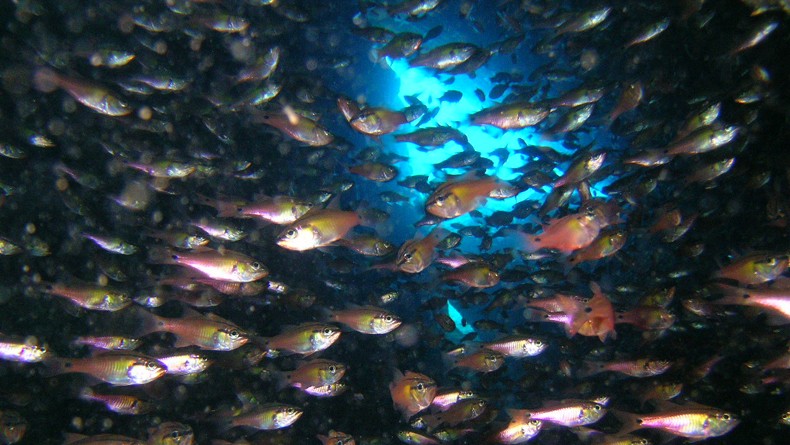The Oki Islands: Diving into the Sea of Japan
Enter the underwater realm of the Sea of Japan and you are sure to notice certain things. First, there is the environment that surrounds you, from the rich beds of seaweed to the seemingly endless carpet of white sand dotted with rocks of all shapes and sizes. Perhaps even more inviting is the great abundance and diversity of fish and little critters. Most divers can attest to spotting schools of damselfish, a multitude of starfish and crabs, and perhaps even an interesting-looking blenny or two. But delve a little further under the seaweed or peer down a small crack in the rocks, and you're sure to find some of the more elusive creatures like shrimp that also inhabit this scene so typical of the Sea of Japan.
The Oki Islands consist of four large inhabited islands in the Sea of Japan and around 180 smaller uninhabited ones, with Dogo Island (Okinoshima) being the largest, followed by the Dozen Islands that include Nishinoshima, Nakanoshima and Chiburijima. During my stay I dived off Nishinoshima and Okinoshima.
Iguri, Nishonoshima
Two large rocks about 10 minutes away from the mainland are the highlights of this dive site that’s suitable for divers of any level. At first it’s a little monotonous with nothing but sand, seaweed and rocks, but if you like studying what you see in detail, you won’t be disappointed. There are a variety of small, benthic fishes here and it’s worth devoting a great deal of time and enjoyment hunting them down. As well as small fish, this site is also home to brightly colored nudibranchs hidden away under the rocks and ledges, and there are a few that are almost like masters of camouflage, as you need to look very closely to be able to spot them. The maximum depth of this site is about 16 to 20 meters.
Hoshi-no-kami-shima, Nishinoshima
If you’re up for some mild to strong currents and prolific marine life, it’s worth travelling 30 minutes to Hoshi-no-kami-shima, a small, uninhabited island whose walls seem to sink forever into the dark depths of the ocean. They may seem eerie to begin with, but these walls are a great place to spot schools of damselfish, yellowtail amberjack and chicken grunts drifting off into the distance. Depending on the current, the best way to explore this site is to start at around 25 meters and ascend slowly, taking time to study the walls. Small forests of soft coral hang limp, swaying in the water and slowly coming to life, fed by the current. They provide an interesting contrast with the seaweed in the shallower depths. Don’t forget to look up from the walls now and then, as sea bream circle close by and groups of sardines glide overhead.
Oki-no-Tatami, Okinoshima
The main feature of this site is a huge rock that divers spend time exploring, and the abundance of fish life on and around it, such as damselfish, sea urchins, crabs and turban shells, is surprising. The rock is covered in green algae and juvenile seaweed, where schools of fish congregate and frequently feed towards the top, while smaller fish such as blennies have made a home in the dark holes and cracks of the rock. Some of them look quite comical with huge eyes and feathery tentacles, peering out at you from their lairs. Good buoyancy and a decent light are a must to get some close-up shots of these comical creatures. Other forms of marine life such as tiny crabs and fish seem to blend in perfectly with the seaweed here, so it takes a sharp eye to spot whatever hides within.
The Deets
Getting there: Flights are available with JAL, ANA and SKJ. The ANA and SKJ flights go from Tokyo’s Haneda Airport to Yonago Airport in Tottori Prefecture. From here, take a taxi or bus to Shichirui Port (or taxi, bus or train to Sakaiminato Port) where high-speed and slower ferries go to both the Dozen and Dogo areas of the Oki Islands. The JAL flights go to Oki Airport on Dogo via Osaka (Itami Airport) and Izumo (Izumo Airport). Ferries from any one of the four Oki ports take visitors back to Shichirui Port or Sakaiminato Port.
Getting around: The best way to get around the Oki Islands is to hire a car. There are rental car companies on each island. Make sure you book a car in advance (click here for more information). Diving schools offer pick-up and drop-off services if you ask in advance. You can use the scheduled sightseeing bus and boat tours (April–October) in Nishinoshima. There are rental bicycles (standard or electric-assist), which can be rented at the ports. If you like walking, you can explore the islands on foot.
Where to Stay and Eat: Fukuro is a traditional Japanese inn (minshuku) on Nishinoshima. It’s a friendly family-run place on the waterfront with basic rooms containing a TV, kettle, futon bedding, and wifi. Dinner and breakfast (food includes, among others, rice, miso soup, fish, squid, shellfish (turban shell), pickles, salad and green tea) are provided. Michizaka is a spacious and family-run minshuku on Okinoshima with a huge room where guests eat dinner and breakfast. A bath can be run for you in the evening. Nadagiya is another type of traditional Japanese inn called a ryokan, about two minutes from Saigo Port. It’s an old building with tatami straw mats and paper doors. Breakfast is available.
Other places to stay include the Oki Seaside Hotel Tsurumaru on Nishinoshima. It’s a complex with its own yacht harbor, where guests can enjoy views of the ocean from Japanese-style rooms. The restaurant offers some extremely fresh seafood such as turban shell and rainbow scallops, as well as conventional dishes for those wanting something a bit less challenging. Tsukudaya, on Okinoshima, is a guest house with traditional Japanese rooms and a kitchen that guests are free to use. The owner, Saki-san, also offers fishing trips or tours etc. and can put you in touch with kayaking instructors. You can also cook with her, using fresh local ingredients.
More Information: For further details on diving off the Oki Islands, contact Nicola Jones at the Nishinoshima Tourism Office, who can contact the relevant dive schools and arrange accommodation and transport.
Top, middle and bottom photos by Eiji Yanagihara of Club Noah Oki.
















